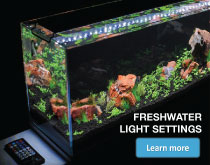Maximize DC Pump Lifespan: Updated Care Tips

Water circulation is often considered the most vital component of any aquarium system. From providing oxygen and gas exchange to ensuring biofiltration, it’s usually the “heart” of any aquarium.
Your aquarium DC water pump consists of a few moving parts, powered and controlled by a few electrical components, all exposed to a “not-so-nice” environment. When exposed to saltwater, algae, debris, humidity, and heat, these parts can begin to deteriorate.
Following these simple tips for cleaning, upkeep, and following a regular schedule of maintenance (monthly or bi-monthly) will help ensure your pump continues to run at optimal performance and maximize its lifespan.
KEEP IT CLEAN
Keeping your water pump properly cleaned is crucial for good performance and should be done at least monthly or bi-monthly. Removing any debris, calcareous algae build-up will protect its moving parts from excessive wear caused by friction, prevents them from “freezing up,” and maximizes performance by ensuring unrestricted water flow. This is especially true in reef aquariums.
HOW TO CLEAN YOUR DC PUMP:
- Turn off power, disconnect the pump from the controller and remove it from the system.
- Disassemble and clean the inlet/outlet fittings, strainer and volute (front of pump).
- Slide out the impeller out and ensure that it’s clean of any dirt, debris, and has no coralline algae build-up.
- If you see any calcium precipitate, soak the pump and components in a 25/75 solution of muratic/citric acid and freshwater for -2 hours to break apart any precipitates and make it easier to clean.
- Re-assemble the pump and ensure the O’Ring is properly in place.
ADDITIONAL PUMP CLEANING TIPS:
- Don’t use vinegar: Vinegar mixed with freshwater is often used for cleaning aquarium equipment, but when “soaking” components for cleaning – it can also penetrate the plastic and cause it to oxidize and swell. This can change the size / tolerance of your pump parts and is not recommended.
- Keep your inlet clean – DC pumps are designed “pump” and push water and maximizing water flow at the intake is vital for optimal performance. Be sure to keep your intake clean of any coralline algae, debris or dirt.
KEEP IT COOL
- Make sure the area around the power supply and pump controller (usually inside your cabinet) is well ventilated. Keep any cooling fans clean and free of lint, grease, dust. This may mean cleaning it often, at least once a week.
- Use the controller mounting bracket included, it provides an air gap for additional controller ventilation.
- Don’t stack your power supplies! (Remember…power supplies hate excess heat.)
- Ensure you’re using a correctly sized power supply. We oversize the power supply included to ensure a long lifespan, using a smaller power supply will cause it to overwork, overheat and shorten its life.
KEEP IT NEAT
- Avoid tightly wrapping power cords – While it may be tempting to wrap your power cords in a tight bunch to keep them organized, doing so can shorten the life of your transformer. This practice puts repetitive stress on the thin copper conductors inside power cords and can cause them to break.
- Avoid wire contact with sharp edges – Exposed wires are a big no-no, and extended contact with sharp surfaces like glass sump edges can wear away the rubber protecting the pump cable.
KEEP IT DRY (AND SAFE)
- Don’t get your power supply, power supply cords, electrical outlets, or pump controller wet – ever.
- ALWAYS, ALWAYS have your electrical components plugged into a GFCI.



